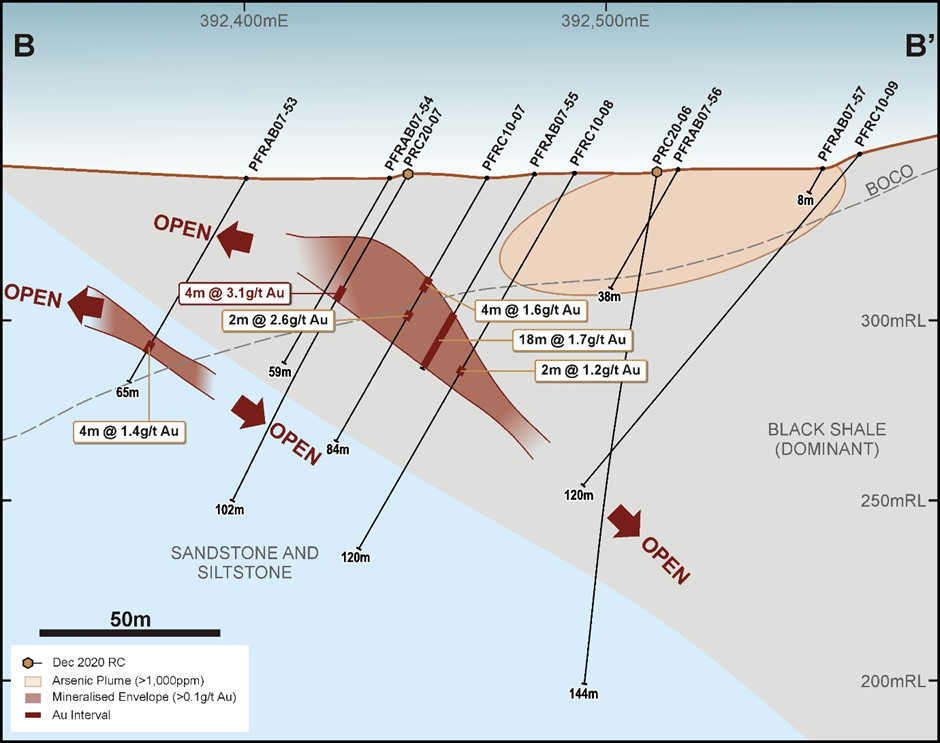PROJECT
Penny’s Gold Project
TARGET COMMODITY
Gold
LOCATION
Goldfield’s region of Western Australia, 45km northeast of Kalgoorlie.
TENEMENTS
27.7km2 of exploration and prospecting tenements either granted or under application.
SUMMARY
Geologically, Penny’s Gold Project is located within the Gindalbie domain, a fault bounded subdivision of the north-northwest trending Gindalbie greenstone belt of the Archean Yilgarn Craton.
The Gindalbie domain comprises a layered sequence of supracrustal rocks that have been deformed, metamorphosed and intruded by granitic rocks. The sequence has been divided into three main units. A basal unit consisting of a tholeitic suite comprising basalt, komatiite and calc-alkaline volcanic rocks. This basal unit is unconformably overlain by a bimodal suite of mafic and felsic volcanic rocks with subordinate sub-aqueous volcanoclastic sandstone, referred to as the Gindalbie Volcanics. Both the basal unit and the overlying Gindalbie Volcanics have been intruded by mafic to intermediate sills and dykes that are co-magmatic with the Gindalbie Volcanics. The uppermost unit is separated from the underlying Gindalbie Volcanics by an unconformity and consists mostly of coarse clastic sedimentary rocks named the Penny’s Dam Conglomerate.
Deformation has occurred during several events resulting in complex re-folding of earlier folds and extensive shearing and faulting at local and regional scales. Gold mineralisation formed during a late deformational event but has been affected by subsequent post-mineralisation deformation.
Several major structures transect, or are proximal to the project area, such as the Emu Fault, and the Gindalbi-Mayday-Queen LePage (GMQ) Shear. The Emu Fault is a major regional shear zone which extends 200km northwards to the Leonora region where it merges with the Keith-Kilkenny Fault. Subsidiary shear zones that splay off the Emu Fault and the GMQ Shear are common and appear to influence the spatial distribution of gold mineralisation. These subsidiary faults may form the loci of gold mineralisation where they join, bifurcate, or create dilation zones. This is evidenced at the nearby Penny’s Find Gold Mine (ASX:HRZ/ASX:ONX), and is characteristic of other gold deposits within the Archaean Goldfields.
During the June 2019 quarter the Company engaged an independent geological consultant to complete a comprehensive geological review of Penny’s Gold Project. The review included the collection, collation and interpretation of geochemical (surface and drilling), geological mapping and geophysical datasets (aeromagnetic and electromagnetic surveys) from Company and historical sources. The geological review focused on generating new target areas within the project limits that are prospective for gold mineralisation.
The review has identified two broad, previously untested areas (refer ASX:ERL “Exploration Projects Update” 11 September 2019) by targeting structurally controlled gold mineralisation comparable to the Penny’s Find Gold Mine (now excluded from the Project area), where 18,356oz was recovered by Empire from 138,272 tonnes grading 4.47g/t Au between 2017 and 2018 (refer ASX:ERL “Financial Results from Penny’s Find Open-Pit Operations” 25 July 2018).
Penny’s Gold Project has multiple prospects and targets at various stages of exploration development.

Figure 1 – Penny’s Gold Project Deposits, Prospects and Historical Drill Collar Locations.
PF09 – WIDESPREAD SUPERGENE DISCOVERY
The PF09 prospect was identified by the Company in late 2019 from historic soil geochemistry data. Initial aircore drilling identified anomalous zones of gold with assay values up to 1,021ppb Au. Follow up aircore and RC drilling in 2020 has expanded the supergene anomaly and intersected gold mineralisation in the bedrock.
Maiden bedrock gold mineralisation intersected at PF09 includes 1m @ 7.27g/t Au and 7,396ppm As from 153m in hole PRC20-03 within a mineralised alteration halo grading 3m @ 2.54g/t Au and 3,976ppm As from 151m (refer ASX:ERL “Encouraging Gold Intercepts at Penny’s” 29 March 2021). Mineralisation at PF09 is associated with quartz veining, disseminated pyrite and arsenopyrite, and ductile shearing in an ultramafic rock unit.
Gold mineralisation at PF09 is strongly associated with arsenic (As), a gold pathfinder element common to Goldfield’s-style mineral systems. The strong correlation of Au and As at PF09 is an encouraging result for the Company and warrant follow up drilling.

Figure 2 – PF09 Prospect 6,628,850mN Cross Section.
PF04
PF04 is in a structural and geological setting directly analogous to the historical Penny’s Find Gold Mine, where mineralisation is related to a north to north-northwest trending fault zone on the contact between mafic rocks and sediments.
In 2007 RAB hole PFRAB07-55 returned 18m @ 1.7ppm Au from 44m, including 2m @ 2.11ppm Au at the bottom of hole (refer ASX:ERL “Results of RAB Drilling at Penny’s Find” 3 October 2007).
RC drilling has confirmed PF04 lies along the western margin of a significant geological boundary, which is associated with an anomalous geochemical gold signature (>50ppb Au). PF04 is dominated by a significant arsenic plume (>1,000ppm As) and anomalous gold in RAB/AC drilling (>0.1g/t Au) across multiple lines spaced over 2km.

Figure 3 – PF04 Prospect 6,623,900mN Cross Section.
COMPETENT PERSON STATEMENT
The information in this report that relates to Exploration Results is based on information compiled and/or reviewed by Gerald Johnson, who is a Member of the Australasian Institute of Mining and Metallurgy. Mr Johnson is an independent geological consultant and has sufficient experience that is relevant to the style of mineralisation and type of deposit under consideration and to the activity he is undertaking to qualify as a Competent Person as defined in the 2012 Edition of the “Australasian Code for Reporting of Exploration Results, Mineral Resources and Ore Reserves”. Mr Johnson consents to the inclusion in the report of the matters based on this information in the form and context in which they appear.

